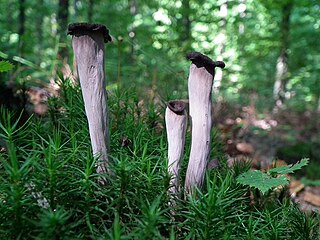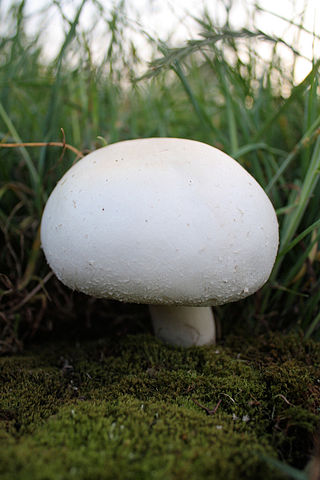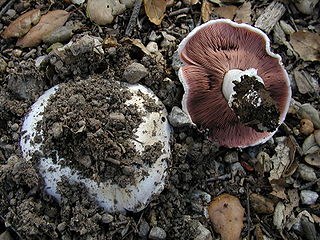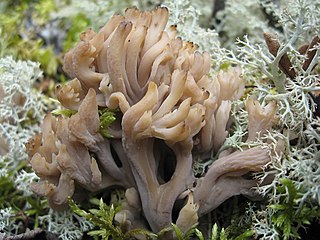
Agaricus xanthodermus, commonly known as the yellow-staining agaricus, yellow-staining mushroom or yellow-stainer, is a mushroom of the genus Agaricus, which displays a strong yellow colouration at the base of the stem when cut. It has a phenolic smell. It is poisonous for most people, causing gastrointestinal upset, but can be eaten by some without apparent negative effect.

Craterellus is a genus of generally edible fungi similar to the closely related chanterelles, with some new species recently moved from the latter to the former. Both groups lack true gills on the underside of their caps, though they often have gill-like wrinkles and ridges.

Pluteus cervinus, commonly known as the deer shield, deer mushroom, or fawn mushroom, is a species of fungus in the order Agaricales. Fruit bodies are agaricoid (mushroom-shaped). Pluteus cervinus is saprotrophic and fruit bodies are found on rotten logs, roots, tree stumps, sawdust, and other wood waste. The species is common in Europe and eastern North America, but rare and possibly introduced in western North America.

Agrocybe is a genus of mushrooms in the family Strophariaceae. The genus has a widespread distribution, and contains about 100 species.

Agaricus arvensis, commonly known as the horse mushroom, is a mushroom-forming fungus of the genus Agaricus.

Agaricus bitorquis, commonly known as torq, banded agaric, spring agaric, banded agaricus, urban agaricus, or pavement mushroom, is an edible white mushroom of the genus Agaricus, similar to the common button mushroom that is sold commercially. The name supersedes Agaricus rodmani.

Gymnopus dryophilus is a mushroom commonly found in temperate woodlands of Europe and North America. It is generally saprophytic, but occasionally also attacks living wood. It belongs to section Levipedes of the genus, being characterized by a smooth stem having no hairs at the base. Until recently it was most frequently known as Collybia dryophila.
Cortinarius caperatus is an edible mushroom of the genus Cortinarius found in northern regions of Europe and North America. It was known as Rozites caperata for many years before genetic studies revealed that it belonged to the genus Cortinarius. The fruit bodies appear in autumn in coniferous and beech woods as well as heathlands in late summer and autumn. The ochre-coloured cap is up to 10 cm (4 in) across and has a fibrous surface. The clay-colored gills are attached to the stipe under the cap, and the stipe is whitish with a whitish ring. The Latin specific name, caperatus, means wrinkled, and refers to the distinctive texture of the cap. The flesh has a mild smell and flavor.

Lactarius uvidus, commonly known as the purple staining milk cap, is a European and North American "milk-cap" mushroom, of which the milk turns violet when the flesh is damaged. The fungi generally identified as L. uvidus are part of a complex of closely related species and varieties which are difficult to delimit definitively.

Clavulina cristata, commonly known as the wrinkled coral fungus, white coral fungus or the crested coral fungus, is a white- or light-colored edible coral mushroom present in temperate areas of the Americas and Europe. It is the type species of the genus Clavulina.

Ampulloclitocybe clavipes, commonly known as the club-foot or club-footed clitocybe, is a species of gilled mushroom from Europe and North America. The grey brown mushrooms have yellowish decurrent gills and a bulbous stalk, and are found in deciduous and conifer woodlands. Although considered edible, disulfiram-like reactions have been reported after consumption of alcohol after eating this mushroom.

Agrocybe pediades, commonly known as the common fieldcap or common agrocybe, is a typically lawn and other types of grassland mushroom, but can also grow on mulch containing horse manure. It was first described as Agaricus pediades by Swedish mycologist Elias Magnus Fries in 1821, and moved to its current genus Agrocybe by Victor Fayod in 1889. A synonym for this mushroom is Agrocybe semiorbicularis, though some guides list these separately. Technically it is edible, but it could be confused with poisonous species, including one of the genus Hebeloma.

Clavaria zollingeri, commonly known as the violet coral or the magenta coral, is a widely distributed species of fungus. It produces striking tubular, purple to pinkish-violet fruit bodies that grow up to 10 cm (3.9 in) tall and 7 cm (2.8 in) wide. The extreme tips of the fragile, slender branches are usually rounded and brownish. A typical member of the clavarioid or club fungi, Clavaria zollingeri is saprobic, and so derives nutrients by breaking down organic matter. The fruit bodies are typically found growing on the ground in woodland litter, or in grasslands. Variations in branching and color can often be used to distinguish C. zollingeri from similarly colored coral fungi such as Alloclavaria purpurea and Clavulina amethystina, although microscopy is required to reliably identify the latter species.

Agaricus silvaticus, otherwise known as the scaly wood mushroom, blushing wood mushroom, or pinewood mushroom, is a species of mushroom often found in groups in coniferous forests from early summer, or September through to November in Europe, North Africa and North America.

Lepiota clypeolaria, commonly known as the shield dapperling or the shaggy-stalked Lepiota, is a common mushroom in the genus Lepiota. It is widely distributed in northern temperate zones, where it grows in deciduous and coniferous forest. Fruit bodies have a brownish cap, a shaggy stipe with a collapsed, sheathing ring or ring zone, and spindle-shaped spores.

Melanoleuca melaleuca is a species of mushroom in the family Tricholomataceae, and it is the type species of its genus Melanoleuca. It is difficult to distinguish from other related species firstly because it is variable, secondly because the taxonomic criteria are often based on characteristics which have later been found to be variable, and thirdly because there is much disagreement between authorities as to exactly how the species should be defined.

Tricholoma fulvum is a mushroom of the agaric genus Tricholoma. One guide reports that the species is inedible, while another says the fruit bodies are edible.

Morchella deliciosa is a species of edible fungus in the family Morchellaceae. It was first described scientifically by Elias Magnus Fries in 1822. It is a European species, although the name has erroneously been applied to morphologically similar North American morels.

Suillus flavidus is a bolete mushroom in the genus Suillus native to Europe. It is considered endangered in the Czech Republic and Switzerland. It is also considered edible, but with an unpleasant taste.

Mycetinis scorodonius is one of the garlic-scented mushrooms formerly in the genus Marasmius, having a beige cap of up to 3 cm and a tough slender stipe.



















